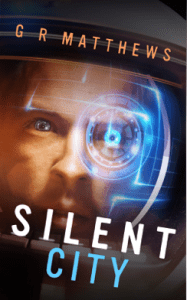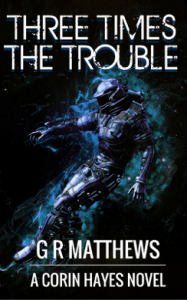 About the Author
About the Author
Geoff Matthews began reading in the cot. His mother, at her wits end with the constant noise and unceasing activity, would plop him down on the soft mattress with an encyclopaedia full of pictures then quietly slip from the room. His father, ever the pragmatist, declared, that they should, “throw the noisy bugger out of the window.” Happily this event never came to pass (or if it did Geoff bounced well). Growing up, he spent Sunday afternoons on the sofa watching westerns and Bond movies with the self-same parent who had once wished to defenestrate him. When not watching the six-gun heroes or spies being out-acted by their own eyebrows he devoured books like a hungry wolf in the dead of winter. Beginning with Patrick Moore and Arthur C Clarke he soon moved on to Isaac Asimov. However, one wet afternoon in a book shop in his home town, not far from the standing stones of Avebury, he came across a book by David Eddings – and soon Sci-Fi gave way to Fantasy. Many years later, Geoff finally realised a dream and published his own fantasy novel, The Stone Road, in the hopes that other hungry wolves out there would find a hearty meal.
—
In science fiction we almost always look to the stars for our future. We imagine great starships plying trading routes, great wars, space stations and hard bitten rogues who don’t give a damn for the rules. You think; Star Wars, Star Trek, Peter F Hamilton, Iain M Banks, Kameron Hurley, Battlestar Galactica, Firefly, Asimov, Clarke, Robinson; stories that span galaxies and eons.
There is an undoubtable allure to space and pushing those boundaries – diving into that void and exploring what we can be, might be and maybe never will be. However, now that I have whet your appetite for those kind of stories, I am going to talk to you about another frontier, another setting for SciFi, and I am going to ask you to fill up your oxygen tank, or if you’re really brave clamber into your Fish-Suit and breathe down that Oxyquid.
We’re heading for the deep… it is cold, dark and full of adventure.
It isn’t difficult to imagine a possible future where we have a civilisation, or at least habitats and factories, at the bottom of the sea. The oceans cover seventy percent of the earth’s surface – over two thirds – and we are crowded on the third that’s left, and a lot of that is uninhabitable. Think about it; hot and cold deserts, mountains, forests. We lose a lot land that way. It is kind of amazing we have any room to live at all!
To make it worse, our resources are dwindling at an ever increasing rate. Below the ocean, below the mud that covers the plains down there, there are a myriad of resources just waiting to be exploited – as long as we do it carefully and sustainability. There is food, fish, crustaceans, plants. Energy from tides, currents, thermal vents. If it wasn’t for the tiny problem of the crushing pressure we’d be down there now.
It has been thought about before, in different ways, on television, in films and in books.
 SeaQuest DSV (1993 – 1996) may have been closer to the truth than we realised at the time. Starring the man who killed Jaws, a dolphin and a teenage genius (Wesley Crusher underwater… in bigger sweaters) the SeaQuest patrolled the seas solving drama’s, quite often with an ecological edge to them. With that kind of sales pitch it is probably hard to understand that the series tried to bring politics, culture, science and science fiction into the same place and only managed four series. A world above of governments struggling to create a utopia and a below-the-sea culture of corporations, shaky governments and frontier style living.
SeaQuest DSV (1993 – 1996) may have been closer to the truth than we realised at the time. Starring the man who killed Jaws, a dolphin and a teenage genius (Wesley Crusher underwater… in bigger sweaters) the SeaQuest patrolled the seas solving drama’s, quite often with an ecological edge to them. With that kind of sales pitch it is probably hard to understand that the series tried to bring politics, culture, science and science fiction into the same place and only managed four series. A world above of governments struggling to create a utopia and a below-the-sea culture of corporations, shaky governments and frontier style living.
Of course, as you’re all shouting right now, that this is far from the first example. Let’s go back in time to 1870 and Jules Verne – 20,000 Leagues Under The Sea. In this classic we are first introduced to Captain Nemo, a man who has rejected everything the world above the seas has to offer and has chosen to live beneath the waves. They farm seaweed, hunt fish, and travel the eponymous 20,000 leagues around the world in Submarine so far in advance of anything that existed in the day, and today in many ways.
Submarines, the essential tool to living under the water, are not new. There are stories, written down in the 16th Century, of Alexander The Great employing divers and diving bells during his campaign around the Mediterranean – admittedly, that’s a less than reliable source (it being written almost two thousand years later), but it shows that people were thinking about it even then (in the 1500s, not 300BCs – though who knows?). If we are going to live under the sea, we would need better technology than we have currently. We’ll need to build cities, learn to draw power and sustenance from the oceans. More than anything we will need to deal with the pressure at depth, and that presents so many problems for us. We’re not evolved to live there and we breathe air.
Consider it for a moment. Take a pen and draw a spider diagram or a mind map… start with the problems we’ll face, the immediate ones and then draw out from there. Keep adding all the complications to life under the ocean.
Oxygen? Well, that’s in the sea water if we can find a way to separate it from the Hydrogen. We can use electrolysis for that, simple. Except now we need a constant supply of power to keep that running (add power to your diagram), but keep going on this chain. Oxygen at high levels (percentage of the atmosphere) and high pressures, even just 3 bars of pressure (20m deep), can cause convulsions after just ten minutes. We need to keep the oxygen at similar levels to the surface (21% or so) if we want to live in the deeps, which means we need more gases to “bulk out” the atmosphere… and they can’t be poisonous. Add that to your diagram. Then you’ve got to get rid of the Carbon Dioxide and do that for a whole civilisation that is contained in a city – no wind, no fresh air coming in, and no kilometres of atmosphere above your head.
And that’s not even one full chain of problems, solution and consequence. If we’re going to live under the ocean it is going to take a lot of effort, a lot of science, and a lot of driven individuals and companies.
But what if we had no choice? What if, for whatever reason, the surface world could no longer support us? What if we had to flee below the oceans for our very survival? What would our lives be like?
—
For more about the author’s work…
Even when Corin does something right, it all goes wrong. Now he is on the run from criminal gangs and the law.
With danger coming from every direction, can he save the lives of two children as well as his own? It isn’t going to be easy, but when has life in the corporation controlled cities ever been.
Feedback on Silent City (Corin Hayes, Book #1):
“(A) book that isn’t short on action or imagination and the setting is an interesting change of pace, so check it out!” – Mark Lawrence (Author of Prince of Thorns, Prince of Fools)
“Entertaining and exciting: Silent City is the start of a series I’ll certainly be following with interest.” – Laura M Hughes (Author of Danse Macabre)
“Damn good fun, intriguing as hell, different and exciting, I devoured this book.” – Dyrk Ashton (Author of Paternus)
Outlaw Mountain is a free short story you can find here.
Buy Silent City here.
Buy Three Times the Trouble here.






0 Comments